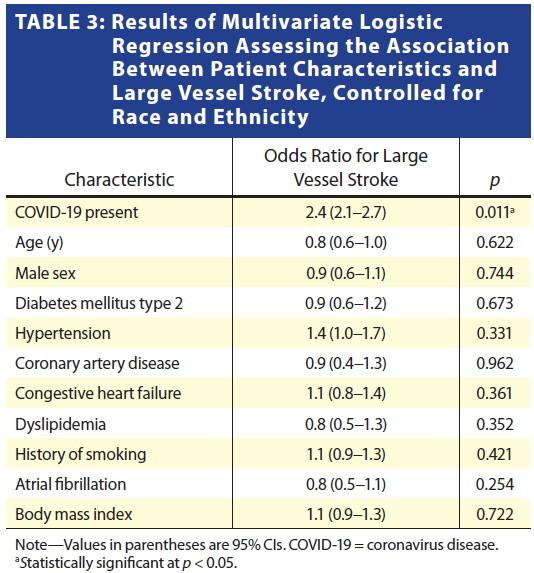After stratification for race and ethnicity, the risk of large vessel stroke among patients with COVID-19 was 2.4 times as high as that among patients without COVID-19

Credit: American Roentgen Ray Society (ARRS), American Journal of Roentgenology (AJR)
Leesburg, VA, July 30, 2020–An open-access article published in ARRS’ American Journal of Roentgenology (AJR) investigating the association between coronavirus disease (COVID-19) and stroke subtypes determined that patients with COVID-19 presenting with acute neurologic symptoms warrant a lower threshold for suspicion of large vessel occlusion (LVO) stroke, thus necessitating prompt workup.
“To our knowledge, this is the first study to describe an association between COVID-19 and large vessel strokes,” wrote lead investigator Shingo Kihira of the Icahn School of Medicine at Mount Sinai.
This retrospective case-control study included patients for whom a code for stroke was activated during March 16 to April 30, 2020 at a single system of six hospitals across the New York City boroughs of Manhattan, Queens, and Brooklyn. Demographic data (age, sex, and race or ethnicity), COVID-19 status, stroke-related risk factors, as well as clinical and imaging findings pertaining to stroke were collected from the electronic medical record.
Among the 329 patients (175 [53.2%] men, 154 [46.8%] women; mean age, 66.9 years) in the study sample, 35.3% (116) had acute ischemic stroke confirmed with imaging; 21.6% (71) had LVO stroke; and 14.6% (48) had small vessel occlusion (SVO) stroke.
The most commonly observed LVO [62.0% (44/71)] was middle cerebral artery segment M1-M2 occlusion. Meanwhile, multifocal LVOs were observed in only 9.9% (7/71) of patients with LVO stroke.
With COVID-19 present in 38.3% (126/329) of patients, the 61.7% (203/329) of patients without COVID-19 formed the negative control group. LVO stroke was present in 31.7% of patients with COVID-19, compared with 15.3% of patients without COVID-19 (p = 0.001). SVO stroke was present in 15.9% of patients with COVID-19 and 13.8% of patients without COVID-19 (p = 0.632).
As Kihira et al. explained: “In multivariate analysis controlled for race and ethnicity, presence of COVID-19 had a significant independent association with LVO stroke (odds ratio, 2.4) compared with absence of COVID-19 (p = 0.011).”
After stratification for race and ethnicity, the results from this AJR study indicate that the risk of large vessel stroke among patients with COVID-19 was 2.4 times as high as that among patients without COVID-19.
“Although the incidence of SARS-CoV-2 infection in New York City is declining, a large population of patients continue to present with COVID-19,” Kihira and colleagues noted. Clarifying that COVID-19 is associated with LVO stroke–but not with SVO stroke–the authors of this AJR article reiterated the lower threshold of suspicion for large vessel stroke in COVID-19 patients who present with acute neurologic symptoms.
###
In the latest AJR Podcast episode, Benjamin Kipper at UC Davis Medical Center in Sacramento further examines the association between COVID-19 and stroke subtypes, as well as the effects this association can have on clinicians and radiologists: https:/
Founded in 1900, the American Roentgen Ray Society (ARRS) is the first and oldest radiological society in North America, dedicated to the advancement of medicine through the profession of radiology and its allied sciences. An international forum for progress in medical imaging since the discovery of the x-ray, ARRS maintains its mission of improving health through a community committed to advancing knowledge and skills with an annual scientific meeting, monthly publication of the peer-reviewed American Journal of Roentgenology (AJR), quarterly issues of InPractice magazine, AJR Live Webinars and Podcasts, topical symposia, print and online educational materials, as well as awarding scholarships via The Roentgen Fund®.
Media Contact
Logan K. Young
[email protected]
Original Source
https:/
Related Journal Article
http://dx.




